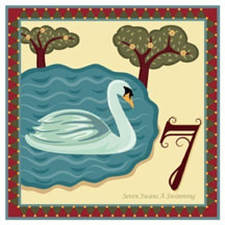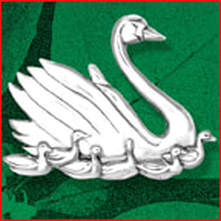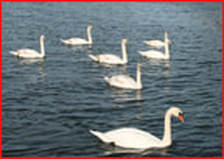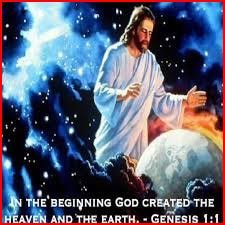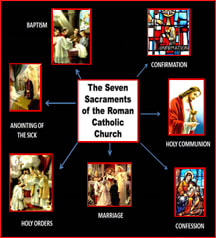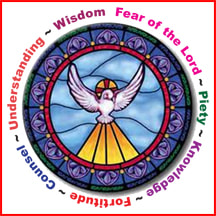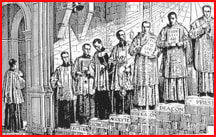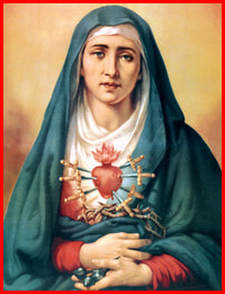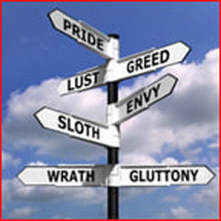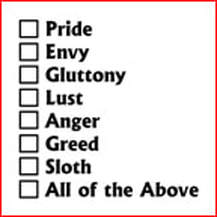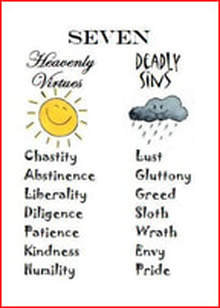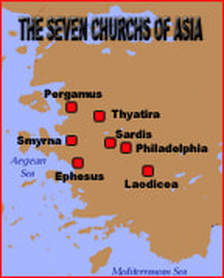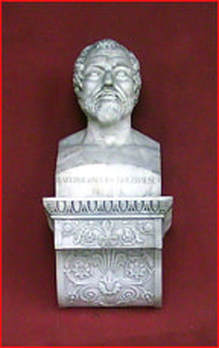| Devotion to Our Lady |
|
- Homepage
-
Daily Thoughts
- 2023 October Daily Thoughts
- Daily Thoughts Lent 2020
- Daily Thoughts for Advent 2019
- Daily Thoughts for October 2019
- Daily Thoughts for September 2019
- Daily Thoughts for August 2019
- Daily Thoughts for July
- Daily Thoughts for June
- Daily Thoughts for Easter 2019
- Daily Thoughts for Lent 2019
- Daily Thoughts for Christmas
- Daily Thoughts Easter 2022
- Sacred Heart
- Holy Ghost
-
Spiritual Life
- Holy Mass Explained
- First Friday Devotions
- First Saturday Devotions
- The Mercy of God
- Vocations
- The Path Everyone Must Walk >
- Gift of Failure
- Halloween or Hell-O-Ween?
- Ignatian Spiritual Exercises >
- Meditation is Soul-Saving
- Spiritual Communion
- Miraculous Medal
- Enrollment in Miraculous Medal
- St. Benedict Medal
- Holy Water
- Advice on Prayer
- Your Daily Mary
-
Prayers
- September Devotions
- Seven Sorrows of Our Lady
-
Novenas
>
- NV-Help of Christians
- NV-Nativity of Our Lady
- NV-Seven Sorrows
- NV- Sorrowful Heart
- NV-Pope St Pius X
- NV-La Salette
- NV-St Michael Archangel
- NV-Immaculate Heart
- NV-Assumption
- NV-Novena for Fathers
- NV-Novena for Your Mother
- NV-St Raphael Archangel
- NV-Souls in Purgatory
- NV-All Saints Day
- NV-Christ the King
- NV-Divine Motherhood
- NV-Guardian Angels
- NV-Rosary
- NV-Mirac Med
- NV- Imm Conc
- NV - Guadalupe
- NV - Nativity of Jesus
- NV-Epiphany
- NV-OL Good Success
- NV-Lourdes
- NV-St Patrick
- NV-St Joseph
- NV-Annunciation
- NV-St Louis de Montfort
- NV-OL Good Counsel
- NV-Last Supper
- NV-Passion
- NV-Pentecost
- NV-Ascension
- NV-Sacred Heart
- NV-Sacred Heart & Perpetual Help
- NV-Corpus Christi
- NV-OL of Perpetual Help
- NV-Queenship BVM
- NV-OL of Mount Carmel
- NV-St Mary Magdalen
- NV- Im Hrt
- August Devotions to IHM
- Immaculate Heart of Mary
- Litany of Dependence
- Prayers to St Mary Magdalen
- Prayers in Times of Sickness Disease & Danger
- Holy Souls in Purgatory
- Meditations on the Litany of Our Lady
- Special Feast Days
- Prayers to Mary (Mon-Sun)
- Litanies to Our Lady >
- Various & Special Needs
- Our Lady of the Rosary
- Our Lady of Mt. Carmel
- Our Lady of Perpetual Help
- Our Lady of Guadalupe
- Other titles of Our Lady
-
Rosary
- Downloads
- Consecration
- Easter Season
-
Holy Week
- Last Seven Words of Jesus >
- Characters of Passion >
- The Last Days of Christ
- Before Palm Sunday
- Palm Sunday
- Monday in Holy Week
- Tuesday in Holy Week
- Wednesday in Holy Week
- Holy Thursday (Last Supper)
- Holy Thursday (Agony & Arrest)
- Night Vigil with Christ
- Good Friday (Pilate & Herod)
- Good Friday (Way of Cross & Crucifixion)
- Saturday in Holy Week
-
Lent
- Ideas for Lent
- Daily Lenten Planner
- Daily Lenten Liturgy
- From Cold to Hot
- Lent with Aquinas
- Lent with Dom Gueranger
- Virtues for Lent
- History of Penance
- How Expensive is Sin?
- Confession of Sins
- Letter to Friends of the Cross
- Sermons for Lent
- Stations of the Cross >
- Lenten Prayers
- 7 Penitential Psalms
- Lenten Psalms SUN
- Lenten Psalms MON
- Lenten Psalms TUE
- Lenten Psalms WED
- Lenten Psalms THU
- Lenten Psalms FRI
- Lenten Psalms SAT
- Lenten Laughs
- Septuagesima
-
Christmas
- Epiphany Explained
- Suggestions for Christmas
- Food For Thought
- Christmas with Aquinas
- Christmas with Dom Gueranger
- Christmas Prayers
- Candles & Candlemas
- Christmas Sermons
- Christmas Prayers SUN
- Christmas Prayers MON
- Christmas Prayers TUE
- Christmas Prayers WED
- Christmas Prayers THU
- Christmas Prayers FRI
- Christmas Prayers SAT
- Twelve Days of Christmas >
-
Advent Journey
- Purgatory
- Christ the King
- Legion of Mary
- Scapular
-
Saints
-
Martyrs for the Faith
>
- Your Daily Martyr >
- All 365 Days of Martyrs
- Cristeros
- St Valentine & Valentine's Day
- Martyrs--Thomas Becket
- Martyrs--John the Apostle
- Holy Machabees
- Age of Martyrdom
- Carmelites of Compiegne
- Martyrs--Peter & Paul
- Martyrs--John the Baptist
- Martyrs--Andrew
- Martyrs--James the Great
- Martyrs--North American
- Martyrs--Seven Holy Sleepers
- Martyrs--Afra
- School of Martyrdom
- Martyrs--Christina
- Desert Saints >
- Saints for Sinners >
- Saints of Mary >
- History of All Saints Day
-
Martyrs for the Faith
>
- Precious Blood
- Synod 2023
-
Catechism
- Catechism Lesson 1
- Catechism Lesson 2
- Catechism Lesson 3
- Catechism Lesson 4
- Catechism Lesson 5
- Catechism Lesson 6
- Catechism Lesson 7
- Catechism Lesson 8
- Catechism Lesson 9
- Catechism Lesson 10
- Catechism Lesson 11
- Catechism Lesson 12
- Catechism Lesson 13
- Catechism Lesson 14
- Catechism Lesson 15
- Catechism Lesson 16
- Catechism Lesson 17
- Catechism Lesson 18
- Catechism Lesson 19
- Catechism Lesson 20
- Catechism Lesson 21
- Catechism Lesson 22
- Bible Study
-
Calendar
- Miracles
- Apparitions
- Shrines
- Prophecies
- Angels Homepage
- Hell
-
Church Crisis
- Conspiracy Theories
- Amazon Synod 2019 >
- Liberalism & Modernism
- Modernism--Encyclical Pascendi
- Modernism & Children
- Modernism--Documents
- The Francis Pages
- Church Enemies on Francis
- Francis Quotes
- Amoris Laetitia Critique
- Danger of Ignorance (Pius X)
- Restore all In Christ (Pius X)
- Catholic Action (Pius X)
- Another TITANIC Disaster?
- The "Errors of Russia"
- CRISIS PRAYERS
- Election Novena 2024
- The Anger Room
- War Zone
- Life of Mary
- Spiritual Gym
- Stupidity
- Coronavirus and Catholicism
- History & Facts
- Books
- Catholic Family
- Children
- Daily Quiz
-
Novena Church & Pope
- Day 01 Church-Pope Novena
- Day 02 Church-Pope Novena
- Day 03 Church-Pope Novena
- Day 04 Church-Pope Novena
- Day 05 Church-Pope Novena
- Day 06 Church-Pope Novena
- Day 07 Church-Pope Novena
- Day 08 Church-Pope Novena
- Day 09 Church-Pope Novena
- Day 10 Church-Pope Novena
- Day 11 Church-Pope Novena
- Day 12 Church-Pope Novena
- Day 13 Church-Pope Novena
- Day 14 Church-Pope Novena
- Day 15 Church-Pope Novena
- Day 16 Church-Pope Novena
- Day 17 Church-Pope Novena
- Day 18 Church-Pope Novena
- Day 19 Church-Pope Novena
- Day 20 Church-Pope Novena
- Day 21 Church-Pope Novena
- Day 22 Church-Pope Novena
- Day 23 Church-Pope Novena
- Day 24 Church-Pope Novena
- Day 25 Church-Pope Novena
- Day 26 Church-Pope Novena
- Day 27 Church-Pope Novena
- Day 28 Church-Pope Novena
- Day 29 Church-Pope Novena
- Day 30 Church-Pope Novena
- Day 31 Church-Pope Novena
- Day 32 Church-Pope Novena
- Day 33 Church-Pope Novena
- Day 34 Church-Pope Novena
- Day 35 Church-Pope Novena
- Day 36 Church-Pope Novena
- Day 37 Church-Pope Novena
- Day 38 Church-Pope Novena
- Day 39 Church-Pope Novena
- Day 40 Church-Pope Novena
- Day 41 Church-Pope Novena
- Day 42 Church-Pope Novena
- Day 43 Church-Pope Novena
- Day 44 Church-Pope Novena
- Day 45 Church-Pope Novena
- Day 46 Church-Pope Novena
- Day 47 Church-Pope Novena
- Day 48 Church-Pope Novena
- Day 49 Church-Pope Novena
- Day 50 Church-Pope Novena
- Day 51 Church-Pope Novena
- Day 52 Church-Pope Novena
- Day 53 Church-Pope Novena
- Day 54 Church-Pope Novena
- Penance Novena
- Daily WeAtheR Forecast
CLICK ON ANY CHRISTMAS LINK BELOW
(most links are available now, the other links will activated shortly)
TWELVE DAYS OF CHRISTMAS
| 12 Day Homepage | 1st Day of Christmas | 2nd Day of Christmas | 3rd Day of Christmas |
| 4th Day of Christmas | 5th Day of Christmas | 6th Day of Christmas | 7th Day of Christmas
| 8th Day of Christmas | 9th Day of Christmas | 10th Day of Christmas | 11th Day of Christmas | 12th Day of Christmas |
PRAYING THE PSALMS THROUGH CHRISTMAS
| Sundays | Mondays | Tuesdays | Wednesdays | Thursdays | Fridays | Saturdays |
SPIRITUAL READING THROUGH CHRISTMAS
| St. Thomas Aquinas on Christmas | Dom Gueranger on Christmas |
(most links are available now, the other links will activated shortly)
TWELVE DAYS OF CHRISTMAS
| 12 Day Homepage | 1st Day of Christmas | 2nd Day of Christmas | 3rd Day of Christmas |
| 4th Day of Christmas | 5th Day of Christmas | 6th Day of Christmas | 7th Day of Christmas
| 8th Day of Christmas | 9th Day of Christmas | 10th Day of Christmas | 11th Day of Christmas | 12th Day of Christmas |
PRAYING THE PSALMS THROUGH CHRISTMAS
| Sundays | Mondays | Tuesdays | Wednesdays | Thursdays | Fridays | Saturdays |
SPIRITUAL READING THROUGH CHRISTMAS
| St. Thomas Aquinas on Christmas | Dom Gueranger on Christmas |
THE CONTROVERSY OVER THE SONG "THE TWELVE DAYS OF CHRISTMAS"
In the last 20 or so years, there has been quite a bit of controversy over the song The Twelve Days of Christmas. Some say it was a cryptic catechism song, used by the persecuted Catholics of England as a means to teach their children some rudimentary teachings of the Faith under the disguise of a seemingly harmless song. Others contest this, by saying that there is no evidence to back-up this claim and say that the alleged points of doctrine to be found hidden in the song, are ... (click here to read more)
"...Seven Swans-A-Swimming"
|
|
THE NUMBER SEVEN
The number SEVEN brings many spiritual things to mind, here are just a few of them: The SEVEN days established by God, which also constitute the measurement of time which we call one week. The SEVEN Sacraments: Baptism, Confession,Communion, Confirmation, Marriage, Holy Orders, Extreme Unction.. The SEVEN Cardinal Virtues: Faith, Hope, Charity, Prudence, Justice, Fortitude, Temperance. The SEVEN Gifts of the Holy Ghost: Fear of the Lord, Piety, Knowledge, Fortitude, Counsel, Understanding, Wisdom. The SEVEN traditional Steps to the Priesthood: Porter, Exorcist, Lector, Acolyte, Subdeacon, Deacon, Priest. The SEVEN Petitions of the Our Father (see below) THE SEVEN last words of Jesus on the Cross. The SEVEN Sorrows of the Blessed Virgin Mary (see below) The SEVEN Joys of the Blessed Virgin Mary The SEVEN Capital Sins: Pride, Greed, Gluttony, Anger, Lust, Envy, Sloth. The SEVEN Churches of the Apocalypse (Apoc. 1:4). The SEVEN Ages of the Church The SEVEN loaves Our Lord used to feed the four thousand (Mt. 15:32-38). The SEVEN times seventy times that we must forgive others who offend us (Mt. 18:21-22). The SEVEN times Namaan was told to bathe in the River Jordan by the prophet Eliseus. There are many, many more examples filling the pages of Holy Scripture. THE SYMBOLISM OF THE NUMBER SEVEN A number of spiritual perfection. The number is already established at the beginning of time with God's creation, where He creates for six days and rests on the the seventh. This resting on the seventh, puts the sevent over and above the other six days. It also the number that is the foundation for so many other spiritual elements of Christ's religion: the 7 Sacraments; the last 7 of the 10 Commandments that all deal with our neighbor; there are 7 Commandments that say “thou shall not”, the 7 Cardinal Virtues, the 7 Gifts of the Holy Ghost, the 7 steps to the priesthood, the 7 Capital Sins we have to avoid, etc. etc. Add to that the interminable references to the number seven from the Old Testament, and it becomes very clear that this number is somehow very special in God's eyes and for God's Providence. THE SWAN Swans are birds of the family Anatidae within the genus Cygnus. The swans’ close relatives include the geese and ducks. There are six or seven species of swan in the genus Cygnus. Swans usually mate for life. The word swan is derived from Old English swan, akin to the German Schwan and Swedish svan, meaning “to sound”, or “to sing”. Young swans are known as swanlings or as cygnets; an adult male is a cob, an adult female is a pen. The swans are the largest members of the waterfowl family and are among the largest flying birds. Their wingspans can be almost 10 feet from tip of wing to wing. Compared to the closely related geese, they are much larger in size and have proportionally larger feet and necks. The Northern Hemisphere species of swan have pure white plumage but the Southern Hemisphere species are mixed black and white. Although most birds generally do not have teeth, swans are known to be an exception to this, having small jagged ‘teeth’ as part of their beaks used for catching and eating fish. THE SYMBOLISM OF THE SWAN The swan is usually pictured on water, which, since they represent the sacraments, is very appropriate, for water is a symbol of grace. The fact that the Northern Hemisphere swans are pure white is also appropriate, for the sacraments and their graces purify us. The magnificent gracefulness (full of grace) of the swan fits in with this, since the swan (sacrament) is a channel of grace. The necks of swans are longer than that of other waterfowl, and this gives an impression of an aloofness as the head sits high above the water and the earth, just as our minds should be raised above the things of the earth. The fact that they eat fish reminds us of the greatest sacrament, the Holy Eucharist that we must ear, and fits well with the symbol of Jesus, who is often represented as a fish beneath the water. Just like the Apostles, Peter, Andrew, James and John, the swans are 'fishermen' too! THE SEVEN DAYS ESTABLISHED BY GOD The origin of the seven-day week is the religious significance based upon the account of the Seven Days of Creation by God. This was the predominant foundation for the ancient cultures, including the Babylonian and Jewish civilizations. Babylonians celebrated a holy day every seven days. Jews celebrated every seventh day as a holy day of rest from their work, in remembrance of Creation week. There would be four seven-day weeks to a lunar cycle, where the first three weeks would be strictly seven day, but they adjusted the number of days of the final “week” in each month so that months would continue to commence on the new moon. THE SEVEN SACRAMENTS These are the foundation of the Christian life, with Baptism being the most important in the sense that it is the gateway to all the other Sacraments, but the Holy Eucharist is the most important of all seven, since it gives us the Body, Blood, Soul and Divinity of Jesus Christ, and furthermore, it more than just a Sacrament, it is also a Sacrifice, as in the Holy Sacrifice of the Mass. However, from the viewpoint of frequency of reception, then the two legs by which we walk to Heaven are the Sacraments of Holy Communion (Eucharist) and Confession, with these being received as often as possible. These are most precious things that we have, yet they are sadly not valued as much as they should be, alas! THE SEVEN CARDINAL VIRTUES These, much like the Ten Commandments, have three that focus on God, and the rest are mainly to do with our life on earth and interactions with other persons, places and things. Just like the first three Commandments, the first three virtues focus on God, that is why they are called “Theological Virtues” (“theo” being Greek for “God”; and “logos” being Greek for “Word”). They are Faith, Hope and Charity and these three form the foundation of our relationship with God. St. Paul speaks of them in his so-called “Hymn to Charity” in 1 Corinthians 13:1-13, and ends that 'hymn' with the words “ there remain faith, hope, and charity, these three: but the greatest of these is charity.” The other four, called the “Moral Virtues”, Prudence, Justice, Fortitude and Temperance, regulate all the other virtues for our life here below. THE SEVEN GIFTS OF THE HOLY GHOST Though we already receive these seven gifts in Baptism, in, so to speak, seed-like form, it is at our Confirmation that God seeks to raise them to a higher level—if we cooperate with Him. From Baptism to Confirmation we have lived in a childlike spiritual state, as infants and children of God. In Confirmation God seeks to make of us spiritual adults; it is a time for growing up spiritually, a time for greater spiritual maturity. The Seven Gifts of the Holy Ghost have been compared to a wide variety of things analogically: to seven sails on the mast of a ship, that enable the Holy Ghost to breath into them and carry us forward spiritually must faster than if we had row the ship to our destination. A more modern idea is that of comparing them to seven different wavelengths on the radio, by which we tune in to the Holy Ghost and listen to His promptings, warnings, instructions and guidance. Or we could compare the Seven Gifts to seven strings a puppeteer attaches to a puppet in order to control it and make it do what the puppeteer wants. In short, though the Gifts sound like virtues, they are not virtues, but things that perfect our virtues. They are greater than the virtues. If we fully cooperate with them, then we allow the Holy Ghost to take over our lives. A scary though at first, but an infinitely wise move in the end! THE SEVEN STEPS TO THE PRIESTHOOD Sadly, in recent times, the Church has diminished and done away with the traditional seven steps to the priesthood. Within the Catholic Church, the Latin Church traditionally distinguished between the three major holy orders of priest, deacon and subdeacon, and the four minor orders, that of acolyte, exorcist, lector and porter (in descending sequence). In 1972, under Pope Paul VI, the minor orders were renamed “ministries”, with those of lector and acolyte being kept throughout the Latin Church. The rites by which all four minor orders were conferred are still employed for members of some Roman Catholic religious institutes and societies of apostolic life authorized to observe the 1962 form of the Roman Rite. THE SEVEN PETITIONS OF THE OUR FATHER The “Our Father” is commonly known as the prayer with 7 petitions. The #7 always symbolized perfection so the “Our Father” is the prayer with 7 perfect petitions. In other words, any petitions we pray in our own words can be found in any of these 7 petitions of the Lord Prayer. Now St. Luke's version does not have 7 petitions. We only heard 5 petitions in today's Gospel passage: (1) Hallowed be Your Name (2) Your kingdom come (3) Give us each day our daily bread (4) Forgive us as we forgive others (5) And lead us not into temptation. Compared to St. Matthew's version, two petitions are not heard in Luke's passage: (1) Thy will be done (2) Deliver us from evil Matthew's version is the one we're very familiar with. Matthew's version is the one which the Church naturally used since it's more developed and complete. THE SEVEN SORROWS OF THE BLESSED VIRGIN MARY 1. St. Simeon’s Prophecy 2. The Flight into Egypt 3. The Loss of Jesus in the Temple 4. The Meeting of Mary and Jesus on the Way to Calvary 5. The Crucifixion and Death of Jesus 6. The Piercing of the Side of Jesus, and His Descent from the Cross 7. The Burial of Jesus. SEVEN JOYS OF THE BLESSED VIRGIN MARY The Seven Joys were frequently depicted in medieval devotional literature and art. The seven joys are usually listed as: 1.The Annunciation 2.The Nativity of Jesus 3.The Adoration of the Magi 4.The Resurrection of Christ 5.The Ascension of Christ to Heaven 6.The Pentecost or Descent of the Holy Spirit upon the Apostles and Mary 7.The Coronation of the Virgin in Heaven SEVEN CAPITAL SINS (SEVEN DEADLY SINS) There is a seven‑headed monster that each one of us has to fight our whole life through. This monster is SELF‑SEEKING or SELF‑LOVE. Its seven heads are: Pride, Covetousness, Lust, Anger, Envy, Gluttony and Sloth. Bishop Fulton Sheen calls them “the seven pall‑bearers of the soul” and gives them the following names: Self‑love, inordinate love of money, illicit sex, hate, jealousy, over‑indulgence and laziness. (Peace of Soul p. 109). As a result of Original Sin, each one of us has an inborn tendency to assert himself, to make himself the “center” of things, to make his will prevail over that of others. Our great passion is for our highest good, but too often we do not comprehend what this good is, and we seek for it in a wrong way. We need to understand that our highest good is God. God has made Himself our last End and Reward. He has shown us the way to Himself through Christ, who called Himself “The Way.” We must recognize our relationship to God as creatures who have the duty to love and serve Him in the manner He wills and desires, in order that we may possess Him in Heaven, or “save our souls,” as we commonly express it. Now, when we are wrapped up in our own ego, even though we may not realize the fact, everything we think, say and do revolves around our own self. We are really “seeking self,” though we may try to convince ourselves that we are following Christ and seeking God. Plainly, then, the battle against self‑seeking is fought within our own personality. Specifically, it is in our will. In the fountainhead of self‑love and self‑will, pride and all the other Capital Sins have their origin and bring forth a host of offspring, great and small. If we are strongly motivated by self‑seeking, we will seldom “deny” ourselves, as Our Lord taught, by charity, love, sacrifice, humility, obedience, patience, generosity, or whatever the calls of duty and virtue may be. Instead, our self‑love will nourish the vices and we will become more and more ensnared in them. To pursue the path of self‑love is continually to refuse love to God, and such a course is a great danger to salvation. No soul can enter Heaven until it has been purged of all self‑love and self‑will and exists only for God; that is to say, until it is sanctified. Probably for most persons who are saved, a great part of this purging has to be done in Purgatory, because the soul did not do it on earth. But should a soul‑or, to be personal‑should we reject the will of God for our own self‑will and self‑love even until death, God would be forced to reject us for all eternity, because we had rejected Him. Such a rejection means eternal damnation. Our state would then be unchangeably fixed in self‑love and hatred of God, and in Hell we would simply be a “mad center unto ourself” ‑- an ego which must endure without end the unendurable, the unceasing torture of being drawn toward God, and yet being walled‑up in its own eternally hate‑filled self. A knowledge of the myriad disguises in which the Seven Capital Sins mask themselves can enable us to come to self‑knowledge and help us carry on a successful warfare by practicing the opposite virtues. It is impossible for us to combat an enemy whom we do not know, whom we do not see, or whom, perhaps, we mistake for a friend. Yet often this is actually the case with these vices, especially with pride and sloth. Our Lord probably referred to the seven vices when He spoke of the unclean spirit that goes out of a man and roams through desert places seeking a resting place, and finding none, returns with “seven other spirits more wicked than himself” (Matt. 12:45). Naturally, the oftener we consent to the temptations aroused by any of the vices, the deeper root the vice takes in us, until at length, habits of sin are formed which are very hard to break. So we need at all times to be watchful in combating the lesser sins if we are to be victorious in the greater battles we shall have to wage. SEVEN CHURCHES OF THE APOCALYPSE The Seven Churches of Revelation, also known as The Seven Churches of the Apocalypse and The Seven Churches of Asia (referring to the Roman province of Asia, not the entire continent as we know it today), are seven major churches of Early Christianity, as mentioned in the New Testament Book of the Apocalypse. In a revelation, on the Greek island of Patmos, Jesus Christ instructs his servant St. John the Apsotle and Evangelist to: “What thou seest, write in a book, and send to the seven churches which are in Asia, to Ephesus, and to Smyrna, and to Pergamus, and to Thyatira, and to Sardis, and to Philadelphia, and to Laodicea.” THE SEVEN AGES OF THE CHURCH A very complete look upon the Seven Ages of the Church is that of the Venerable Bartholomew Holzhauser (1613-1658). Holzhauser’s idea is: The seven stars and the seven candlesticks seen by St. John signify seven periods of the history of the Church from its foundation to its consummation at the final judgment. To these periods correspond the seven churches of Asia Minor, the seven days of the Mosaic record of creation, the seven ages before Christ, and the seven gifts of the Holy Ghost. Since, he says, all life is developed in seven stages, so God has fixed seven periods for regeneration. The first age of the Church, (1) the Status seminativus, from Christ and the Apostles to Pope Linus and Emperor Nero, is typified by the first day of creation “Spiritus Dei ferebatur super aquas”, the gift of wisdom and the age from Noah. Similarly he treats; (2) the status irrigativus, the days of persecution; (3) status illuminativus from Pope Sylvester to Leo III; (4) status pacifitcus from Leo III to Leo X; (5) status afflictionis et purgativus from Leo X to a strong ruler and holy pope; (6) status consolationis from that holy pope to the birth of Antichrist; (7) status desolationis from Antichrist to the end of the world. From the above division, it therefore seems that we are currently in the several centuries that comprise the Fifth Age of the Church. Here are some extracts from the Venerable Holzhauser on that Fifth Age: “The fifth period of the Church, which began circa 1520, will end with the arrival of the holy Pope and of the powerful Monarch who is called “Help From God” because he will restore everything [in Christ]…” “The fifth period is one of affliction, desolation, humiliation, and poverty for the Church. Jesus Christ will purify His people through cruel wars, famines, plagues, epidemics, and other horrible calamities. He will also afflict and weaken the Latin Church with many heresies. It is a period of defections, calamities and exterminations. Those Christians who survive the sword, plague and famines, will be few on earth. Nations will fight against nations and will be desolated by internecine dissensions…” “During this period the Wisdom of God guides the Church in. several ways: 1) by chastising the Church so that riches may not corrupt her completely; 2) by interposing the Council of Trent like a light in the darkness, so that the Christians who see the light may know what to believe, 3) by setting St. Ignatius and his Society in opposition to Luther. and other heretics; 4) by carrying to remote lands the Faith which has been banned in most of Europe…” “Are we not to fear during this period that the Mohamedans will come again working out their sinister schemes against the Latin church…” “During this period, many men will abuse of the freedom of conscience conceded to them. It is of such men that Jude the Apostle spoke when he said, ‘These men blaspheme whatever they do not understand; and they corrupt whatever they know naturally as irrational animals do… They feast together without restraint, feeding themselves, grumbling murmurers, walking according to their lusts; their mouth speaketh proud things, they admire people for the sake of gain; they bring about division, sensual men, having not the spirit.’” “During this unhappy period, there will be laxity in divine and human precepts. Discipline will suffer. The Holy Canons will be completely disregarded, and the Clergy will not respect the laws of the Church. Everyone will be carried away and led to believe and to do what he fancies, according to the manner of the flesh…” “They will ridicule Christian simplicity; they will call it folly and. nonsense, but they will have the highest regard for advanced knowledge, and for the skill by which the axioms of the law, the precepts of morality, the Holy Canons and religious dogmas are clouded by senseless questions and elaborate arguments. As a result, no principle at. all, however holy, authentic, ancient, and certain it may be, will remain free of censure, criticism, false interpretation, modification, and delimitation by man…” “These are evil times, a century full of dangers and calamities. Heresy is everywhere, and the followers of heresy are in power almost everywhere. Bishops, prelates, and priests say that they are doing their. duty, that they are vigilant, and that they live as befits their state in life. In like manner, therefore, they all seek excuses. But God will permit a great evil against His Church: Heretics and tyrants will come suddenly and unexpectedly; they will break into the Church while bishops, prelates and priests are asleep. They will enter Italy and lay Rome waste; they will burn down the churches and destroy everything.…” “The Sixth Age of the Spirit commences with the powerful Monarch and the Holy Pontiff as previously mentioned and will last until the appearance of the Antichrist. This sixth epoch of the church – “the time of consolation” begins with the Holy Pope and the Powerful Emperor and terminates with the reign of Antichrist. This will be an age of solace wherein God will console His church after the many mortifications and afflictions she has endured in the Fifth period, for all nations will be brought to the unity of the True Catholic Faith.” |
Web Hosting by Just Host

